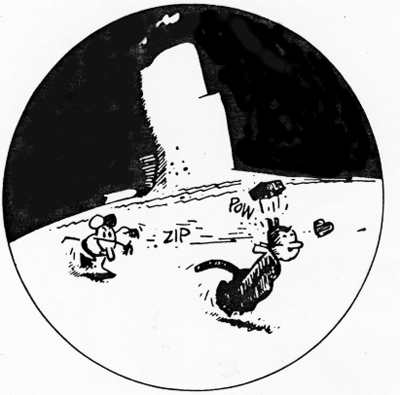Eric had a great comment on Adrielle’s post, so I thought I’d reprint it here.
Noah, when I did a survey of Krazy Kriticism some 5-7 years ago, there wasn’t very much gender/queer stuff, though certainly Krazy’s gender ambiguity were mentioned. My guess, though, is that there is more of that out there now as comics criticism has ramped up in academic circles. I definitely tried to explore that (and the racial elements) in my classes on Krazy. Most interesting to me is how the instability in these “social” areas are reflected by the instability of the settings, backgrounds, etc. of the strip. Everything “behind” the characters is constantly changing and in flux without any rhyme or reason. “Instability” seems to be the watchword of the strip, with the possible exception of the “solidity” of Ignatz’s brick itself. I think M. Thomas Inge talked about the whole strip as a battle between imagination and materiality (Krazy imagines Ignatz loves her, so there is nothing he can physically/materially do to overcome that notion). Inge talks about this, and then that seems to apply to so much of the “comics canon” (to bring things back to the Eliotic realm). Snoopy’s imagination, for instance, vs. Charlie Brown’s “real life” of disappointment and misery. Obviously, Calvin and Hobbes is about the transcendence of the imagination, etc. Even (many/most) superhero comics are all about the “power fantasy” vs. the reality of the disappointing secret identity. Of course imagination vs. reality is such a broad “theme” as to be legible anywhere and in anything. Still, it does seem like a powerful current in Krazy and in the comics canon in general. Things like gender and race then can be considered in that context. Is “gender” simply something we imagine, or is a bedrock reality? The same question might be asked of race, and, in fact, Krazy puts these things in conversation with one another. The earlier discussion about Herriman’s “race” and self-identification also feeds into this. Is there a “truth” to the question of Herriman’s race, or did he “imagine” himself into whiteness, etc. etc. These kinds of things make Krazy a fun strip to think about and talk about (also, the fact that it’s funny).
The whole Krazy Kat roundtable so far on PencilPanelPage is here.


I know less about Herriman and Krazy Kat than anyone here, so I may deserve excoriation for even commenting. I liked Eric’s comment, though. It seemed to me in my limited exposure that the absurdity of the gender/race/relationship/landscape shifting helped make the funny, as well as enabling Herriman to explore the topics.
Bloom County was a very different strip, but it capitalized on outlandish (pun intended) absurdity in similar fashion. They even bordered on reality shifting, with Bill the Cat’s occasional transformation and a basselope that changed her (public) gender identity. Of course, Herriman goes much further, but the reader can still roll with it, which is pretty amazing.
Was Tex Avery influenced by Herriman? He was the weirdest of the Warner Brothers animators, and some of his tricks seem like things Herriman would do.